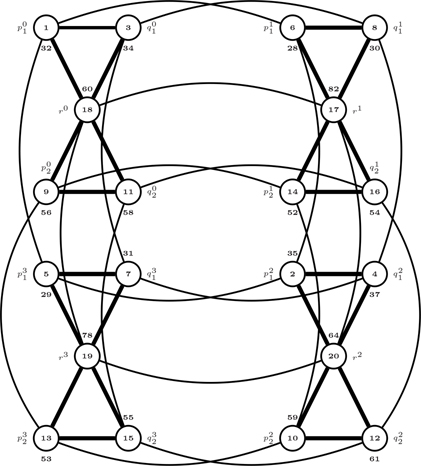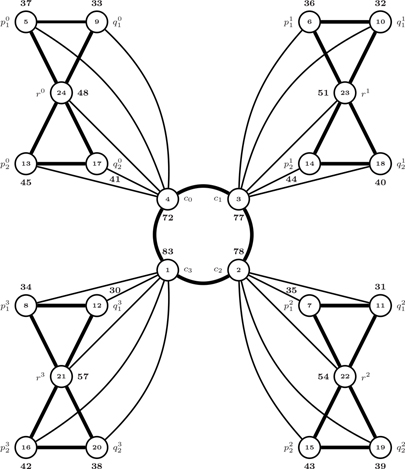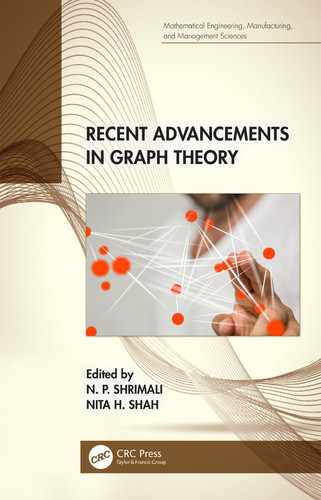16Distance Magic and Distance Antimagic Labeling of Some Product Graphs
N P Shrimali
Department of Mathematics,
Gujarat University,
Ahmedabad,
Gujarat (INDIA)
E-mail: [email protected]
Y M Parmar
Department of Mathematics,
Gujarat University,
Ahmedabad, Gujarat (INDIA)
E-mail: [email protected]
Let G = (V, E) be a graph of order n. Let f:V(G) → {1, 2, …, n} be a bijection. For any vertex q ∈ V(G), the sum is called the weight of the vertex q and is denoted by w(q). If there exists a positive integer γ such that w(q) = γ, for every q ∈ V(G), then f is called a distance magic labeling. The constant γ is called the magic constant for f. A graph which admits a distance magic labeling is called a distance magic graph. If w(q) ≠ w(r) for any two distinct vertices q and r, then f is called a distance antimagic labeling. A graph which admits a distance antimagic labeling is called a distance antimagic graph. In this chapter, we discuss the existence of distance magic labeling and distance antimagic labeling for , , and .
Here, we consider that all graphs G with vertex set V(G) and edge set E(G) are finite and simple. We adopt Gross and Yellen [5] for various graphs and its theoretic notations and for number theoretical results, we follow Burton [3]. For acquiring the latest update, we follow a dynamic survey on graph labeling by Gallian [4].
A distance magic labeling distance magic labeling of a graph G of order n is a bijection f:V(G) → {1, 2, …, n} such that , for all q ∈ V(G), where N(q) is the set of all vertices of V(G) which are adjacent to q. The constant γ is called the magic constant of the distance magic labeling for f. A graph which admits a distance magic labeling is called a distance magic graph. For any vertex q ∈ V(G), the neighbor sum is called the weight of the vertex q and is denoted by w(q).
The concept of distance magic labeling was introduced and studied by many researchers with different terminologies. For example, the term sigma labeling is used by Vilfred [10], the term 1-vertex magic labeling [1-VML] is used by Miller et al. [7], the term neighborhood magic labeling is used by B.D.Acharya et al. [1] and the term distance magic labeling is used by Sugeng et al. [9].
The following lemmas are proved by Miller et al. [7].
Lemma 16.1
[7] A necessary condition for the existance of a distance magic vertex labeling f of a graph G is
where d(p) is the degree of vertex p and v is the number of vertices of G.◼
Lemma 16.2
[7] If G contains two vertices p and q such that , then G has no distance magic labeling.◼
A distance antimagic labeling of a graph G of order n is a bijection f:V(G) → {1, 2, …, n} such that for all q ∈ V(G), where N(q) is the set of all vertices of V(G) which are adjacent to q and w(p) ≠ w(q) for every pair of vertices p, q ∈ V(G). A graph which admits a distance antimagic labeling is called a distance antimagic graph.
A distance antimagic labeling was introduced by Simanjuntak and Wijaya [8] in 2013. They proved the following Lemma:
Lemma 16.3
[8] If a graph contains two vertices with the same neighborhood then it is not distance antimagic.◼
They also proved that cycles, suns, wheel Wn for n ≠ 5, fan Fn for n ≠ 4, friendship graphs fn are distance antimagic graphs and multipartite graphs are not distance antimagic graphs.
Definition. [6] A Cartesian product, denoted by is a graph with vertex set V(G) × V(H). Vertices (p, q) and (p′, q′) in are adjacent if and only if p = p′ and q is adjacent to q′ in H or q = q′ and p is adjacent to p′ in G.
Definition. [6] A Direct product, denoted by G × H is a graph with vertex set V(G) × V(H). Vertices (p, q) and (p′, q′) in G × H are adjacent if and only if p is adjacent to p′ in G and q is adjacent to q′ in H.
Definition. [6] A strong product, denoted by is a graph with vertex set V(G) × V(H). Vertices (p, q) and (p′, q′) in are adjacent if and only if p = p′ and q is adjacent to q′ in H or q = q′ and p is adjacent to p′ in G or p is adjacent to p′ in G and q is adjacent to q′ in H.
Definition. A corona product of two graphs G and H is obtained by taking one copy of G and |V (G)| copies of H; and by joining each vertex of the i-th copy of H to the i-th vertex of G, where 1 ≤ i ≤ |V (G)|.
M. Anholcer and S. Cichacz [2] have already proved that is not distance magic. In this chapter, we apply some more products between and C4. We investigate the existence of distance magic labeling and distance antimagic labeling of , , and graphs.
Throughout this chapter, friendship graph consists of t − triangles with a common vertex r and vertices pk, qk for k = 1, 2, …, t. i.e. pk, qk are the vertices of the kth copy of cycle C3. Let C4 = c0c1c2c3c0 be a cycle. Here, and are graphs with vertex set , where .
16.2Cartesian Product of and C4
Theorem 16.1
The graph is not distance magic.◼
Proof. Suppose that the graph is a distance magic graph under distance magic labeling f. So weights of each vertex are equal.
Now,
Since, w(r0) = w(r2),
(16.1) |
|---|
Now, for 1 ≤ k ≤ t
Since, ,
(16.2) |
|---|
Analogously, we can derive the following equation,
(16.3) |
|---|
Adding the above 2t equations, we get
(16.4) |
|---|
From, (16.1) and (16.4), f(r0) = f(r2), which is not possible.
Hence, the graph is not a distance magic graph.□
Theorem 16.2
The graph is distance antimagic.◼
Proof. We define a vertex labeling f:V(G) → {1, 2, …, |V(G)|} as follows:
For k = 1, 2, …, t,
Under the above labeling, weights for each vertex are as follows:
For 1 ≤ k ≤ t,
Since weights of each vertex are distinct, is a distance antimagic graph.□
Illustration 16.2.1. The distance antimagic labeling for is given in Figure 16.1.

Theorem 16.3
The graph is not distance magic.◼
Proof. Suppose that is a distance magic graph under distance magic labeling f and that magic constant is γ. We have
(16.5) |
|---|
and
(16.6) |
|---|
which implies that
(16.7) |
|---|
so that,
(16.8) |
|---|
Thus,
(16.9) |
|---|
Now, for all k = 1, 2, …, t and j ≡ 0(mod4)
(16.10) |
|---|
But . So,
(16.11) |
|---|
By Equations (16.5) and (16.11)
and by Equations, (16.9), (16.10) and (16.11)
Now, by the above two equations, we get
(16.12) |
|---|
Let us find the sum of labels of all vertices except rj vertices.
(16.13) |
|---|
since, |V(G)| = 8t + 4.
(16.14) |
|---|
Thus, by Equations (16.12)
(16.15) |
|---|
i.e.,
(16.16) |
|---|
Now, f(r0), f(r2) ∈ {1, 2, …, 8t + 4}. If we take f(r0) = 8t + 4 and f(r2) = 8t + 3, then f(r0) + f(r2) = δ = 16t + 7, which is less than . So, equality in (16.16) cannot possible.
Hence, is not a distance magic graph.□
Here, the graph is not a distance magic graph as well as by Lemma 16.3 it is not distance antimagic because neighborhoods of vertex and , for k = 1, 2, …, t are always the same.
Theorem 16.4
The graph is distance antimagic.◼
Proof. We define a vertex labeling f:V(G) → {1, 2, …, |V(G)|} as follows:
For 1 ≤ k ≤ t and j ≡ 0(mod4)
Under the above labeling, weights for each vertex are as follows:
For 1 ≤ k ≤ t, j ≡ 0(mod4),
Here, we can see that, each vertex has distinct weights.
Therefore, the graph is a distance antimagic graph.□
Illustration 16.4.1. The graph with distance antimagic labeling is given in Figure 16.2.

Here, the graph is distance antimagic but it is not distance magic. Since for this graph, , so by Lemma 16.2 it is not a distance magic graph.
Theorem 16.5
The graph is distance antimagic.◼
Proof. Let and vertex set where are the vertices of the (j + 1)th copy of which are adjacent to vertex cj of C4 for j = 0, 1, 2, 3.
We define a vertex labeling f:V(G) → {1, 2, …, |V(G)|} as follows:
For, 1 ≤ k ≤ t and j ≡ 0(mod4),
Under the above labeling, weights for each vertex are as follows:
For 1 ≤ k ≤ t and j ≡ 0(mod4),
One can easily verify that, all weights are distinct.
Hence, the graph is a distance antimagic graph.□
Illustration 16.5.1. The distance antimagic labeling for is given in Figure 16.3.

The corona product of C4 and is a distance antimagic graph but it is not a distance magic graph by Lemma 16.2, since .
Here, we have investigated the existence of distance magic labeling and distance antimagic labeling of certain products of the friendship graph and cycle C4. To explore some new distance magic and distance antimagic graphs is an open problem.
References
1.B. Acharya, S. Rao, T. Singh and V. Parameswaran. Neighbourhood magic graphs. National Conference on Graph Theory, Combinatorics and Algorithm, 2004.
2.M. Anholcer and S. Cichacz. Note on distance magic products G ∘ C4. Graphs and Combinatorics, 31, 1117-1124, 2015.
3.D. M. Burton. Elementary Number Theory. Tata McGraw-Hill, 2007.
4.J. A. Gallian. A dynamic survey of graph labeling. The Electronics Journal of Combinatorics, # DS6, 2018.
5.J. Gross and J. Yellen. Graph Theory and its Applications. CRC Press, 2005.
6.R. Hammack, W. Imrich and S. Klavžar. Handbook of Product Graphs, CRC Press, Boca Raton, FL. 2011.
7.M. Miller, C. Rodger and R. Simanjuntak. Distance magic labeling of graphs. Australas. J. Combin., 28, 305-315, 2003.
8.R. Simanjuntak and K. Wijaya. On distance antimagic graphs. arXiv:1312.7405v1[math.CO], 2013.
9.K. Sugeng, D. Fronček, M. Miller, J. Ryan and J. Walker. On distance magic labeling of graphs. Journal of Combinatorial Mathematics and Combinatorial Computing, 71, 39-48, 2009.
10.V. Vilfred. Σ-labelled Graphs and Circulant Graphs. Ph.D. Thesis, University of Kerala, Trivandrum, India 1994.
